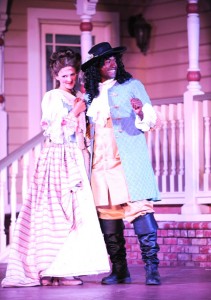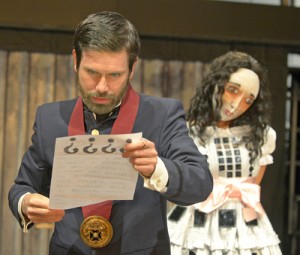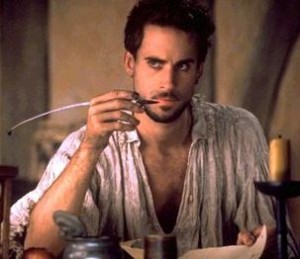Review: THE LIAR at the Livermore Shakespeare Festival
June 25, 2013 § 2 Comments
David Ives is best known for his comedy Venus in Fur, coming to ACT in San Francisco next spring, and his collection of short plays collectively called, All in the Timing. He is also a prodigious adapter, having won awards and attention for his updates of the Mark Twain piece, Is He Dead?, Feydeau’s classic farce A Flea In Her Ear, and Molière’s The Misanthrope. Livermore Shakespeare Festival is now serving up his 2010 “transladaptation” of Pierre Corneille’s The Liar (Le Menteur) in a production that is a perfect introduction to this undeservedly obscure French comedy.
Ives’ version of the play is freely adapted from Corneille, but faithfulness to the original is surely not why we attend neoclassic comedy anyway. He constantly finds verbal twists and topical updates, not to mention cheeky meta-theatrical wisecracks, that make for delightful listening.
 Photo by Kenneth Alexander. Luisa Frasconi and Rafael Jordan in The Liar. Costumes by Barbara Murray. Scenic Design by Randall Enlow.
Photo by Kenneth Alexander. Luisa Frasconi and Rafael Jordan in The Liar. Costumes by Barbara Murray. Scenic Design by Randall Enlow.
The admittedly thin plot concerns a young rake, new to town, who is chronically unable to resist overstating his résumé or embellishing a tale. While keeping him constantly dancing on the edge of a cliff, it proves an effective technique for gaining the attention of eligible young women. (In a wonderful authorial addition by Ives, his servant is given exactly the opposite problem, unable to tell a lie even when he is just one bit of flattery away from the night of his dreams.) A reunion that turns into a run-in with an old friend powers the first act, while the second concerns trying to outwit his good-hearted, but gullible, father’s attempts to make an advantageous match for him. That everything ends happily is due to the plotting of Corneille+Ives and not the characters themselves, but that is how farce works.
Livermore sits about an hour east of San Francisco in a beautiful wine-producing district, where one of its oldest vineyards, Concannon, hosts the festival on its grounds. It is a destination theatre, but without question worthy of the trip to catch this production.
This almost unknown piece is an inspired choice by Artistic Director (also the production director) Lisa A. Tromovitch, for the non-Shakespearean selection on its season. Emerging companies may not yet have the budgets or infrastructure to challenge older, more established theatres but they can score with more adventurous programming. The Shakespeare Theatre, in Washington D.C., commissioned Ives to adapt the piece as part of their rediscovery series. It was the breakout hit of the year. Surprisingly, few other companies have had the courage to stray from the warhorses, so Tromovitch saw and grabbed an opportunity.
Livermore Shakespeare is a sleek, young company of the “passion and two boards” variety. The performance space is a raised deck erected in front of an historic Victorian-style home in the middle of the vineyard. The gingerbread mansion is visually entertaining on its own, but you have to suspend your disbelief and think of it like the neutral façade of Shakespeare’s Globe instead of scenery. It provides a practical second story balcony and entrances from two sides, so as long as you think of it as an open stage it is an excellent Elizabethan playing space.
Restoration era costumes give the night some visual impact, but it is the company’s reveling in Ives’ clever rhymed iambic pentameter, and sly contemporary additions, and not the spectacle that makes the production so thoroughly enjoyable.
At its center is Rafael Jordan as the title character, whose is equally adept at charming the objects of his affection and the audience. (He doesn’t just break the fourth wall, he scarcely acknowledges that it exists.) Jordan is an Equity professional pursuing his MFA with ACT’s famed conservatory. His stellar energy and verbal dexterity make him the evening’s standout. (The highpoint of the night may well have been his narrating his own duel as if he were Howard Cosell, dazzling us and his stunned opponent simultaneously.) To be fair, however, despite the disparate range of experience among the actors – from AEA members to college interns – there is not a weak link in the cast.
Paul Barrios as the truthful servant proved a master of the droll aside, but had his hands full keeping pace with Rebecca Pingree’s bravura turn as twin servants with diametrically opposed temperaments. Without realizing there are two, he is in love with the pert flirt, but keeps running up against the dour dominatrix.
Katheryn Zdan and Luisa Frasconi proved unconventional ingénues, conspiring with Ives to subvert the insipid, sexist stereotypes of Molière’s period. In a very funny evening, few things could top the constantly surprising ways they defied convention – seemingly rewriting the roles while playing them.
The cast was rounded out by Sean Higgins as a wildly jealous – and somewhat dim – suitor to Zdan’s character, Patrick Moore giving an unexpectedly moving reading of the duped, but perpetually forgiving, father, and Jeremy La Clair as the requisite raisonneur, but with a surprising twist that provided the evening’s biggest deadpan laugh.
Tromovitch’s direction was witty, stylish and restrained. She urged her cast toward the right degree of physicality to remind us of French comedy’s indebtedness to Comedia Dell’Arte without ever undermining the verbal effervescence of the evening. It is a hard line to tread, but she got it exactly right.
Pericles at the Berkeley Rep
June 19, 2013 § Leave a Comment
My chief scholarly area of interest is performance of early modern English drama, i.e. the plays of Shakespeare and his contemporaries. As a theatre historian I am also interested in the conditions under which the drama was originally performed, but for their contemporary applications and not some form of historical purity. Indeed, thinking about it recently I realized that in a lifetime of attending Shakespeare live I have never seen a production that so much as attempted an historically correct (whatever that might mean) re-creation, and aside from a few Zeffirelli movie versions can’t even remember anything set in period, without any lack of enjoyment.
My interest then, is not as a purist, but I confess to a fascination with the issue of how modern productions should interpret, extend and/or adapt the written drama. Are the plays ultimately flexible, i.e. tolerant of any and all performance choices, or are there some boundaries – limits to how far they can stretch without breaking? If the latter, what elements of the plays are the source of their enduring power, therefore vitally important?
The great test case is Pericles – the textually troubled step-child of the canon. The play is Shakespeare’s retelling an ancient folktale about a prince’s odyssey around the Mediterranean in search of his lost wife and daughter. Co-written late in his career this “romance” (in the medieval sense of a journey or quest through a partially supernatural landscape) was never published in an authoritative edition so, even more than with the rest of Shakespeare’s plays, there is no definitive script. It has to be “completed.”
 David Barlow and Rami Magron as Pericles and the princess of Antioch
David Barlow and Rami Magron as Pericles and the princess of Antioch
Photo courtesy of mellopix.com
That used to be thought such a drawback that the play was rarely produced, but lately it has become one of the chief appeals of the work. To say that Mark Wing-Davey’s relentlessly eclectic adaptation for eight versatile actors at the Berkeley Rep earlier this spring was less a production of, than a riff on, Pericles just means that it was right in vogue. Wing-Davey’s fame rests on his recontextualizing his texts, and this production confirmed his commitment to the bit. Scene after scene revealed wonderful, unanticipated references ranging from a king costumed like an Assyrian relief as channeled by Klimpt to a wicked stepmother who just stepped out of Sunset Boulevard. But however brilliantly matched this director seemed to be to the task, the production didn’t quite come together – for very instructive reasons.
Although often amusing, his strategy was not always illuminating because Wing-Davey seemed to be placing his considerable invention in service of recontextualizing not the play as a whole, but each individual scene. Occasionally, it appeared, even individual lines. The cumulative effect was too many signifiers without much being signified.
The scenes located in an Italian brothel (already relocated from the text’s Mytilene) into which Pericles’ lost daughter is sold, for example, were inexplicably played using broad Lucy-and-Ricky Cuban accents and comic stereotypes. Pericles was clearly on a wide-ranging odyssey, but his trip seemed less a Joseph Campbell-style hero’s journey and more like a mashup of Hope-Crosby road movies.
This worked best in a long first act sequence in which the hero, Pericles, entered a tournament where the jousting knights were introduced with classical mottoes but individually materialized (after rapid fire costume changes by the tiny cast) in such whimsical guises as Napoleon and then Batman. After winning the tournament, Pericles proved himself not just the bravest knight but also the most graceful dancer with a decent Justin Timberlake imitation, and then shyly wooed his intended bride at a “crowded,” but literally faceless, banquet created by just four actors playing the throng in triple-wide costumes with extra heads.
We got a glimpse of the process that must have led to the energetic and frequently engaging outcome from the almost defensive playbill that had no less than three separate essays extolling adaptation, including a double page spread about the director’s unconventional rehearsal process. The production was obviously remarkably fluid until quite a late date as the printed program stated it would be performed in ninety minutes without an intermission. It actually ran a full hour longer, not counting the fifteen-minute interval that resulted from a decision clearly reached after the copy deadline.
David Barlow was a convincing Pericles as both a young man, and – after the intermission – a middle aged father. Jessica Kitchens, doubling as the wicked step-mother character Dionyza and Pericles’ faithful wife Thaïsa, exhibited extraordinary range. Annapurna Sriram was affecting as Marina in the “recognition scene,” but only after we had seen her struggle through a couple of bit parts and the most of the rest of her central role. The big name in the cast was Anita Carey who was wasted as a pedestrian Gower. No one in the small ensemble cast made the anticipated impact, because of the expedient decision to edit the number of roles in the play down from roughly 45 to about 15. The expected excitement of watching a small cast tackle this huge sprawling piece with theatrical cunning never materialized, because the directorial decisions eviscerated the script – often (it seemed) precisely to keep the challenge to a mundanely manageable size.
In comparison to last year’s off-Broadway breakout hit Cymbeline by the Fiasco Theater, which used just six actors to tackle an even more convoluted romance, Pericles seemed over-designed and under-“dramaturged.” Fiasco stripped the scenery down to a single (but astonishingly tricky) trunk, and let a cast of six play some fifty roles – often delightfully performing two or three simultaneously. By contrast, Berkeley Rep’s production placed all their bets on spectacle and then constrained the cast in ways that undervalued and under-challenged them.
Scenic designer Douglas Stein constructed a variable and eclectic environment around a huge industrial winch that was used to slight purpose several times early in the play. The pay-off was supposed to be the mystical appearance of Diana in a vision to direct Pericles to the location of his long-lost wife. Oddly, however, when the time came to lower Diana in, the moment was played for comedy. Ridiculing the hoary plot device of the deus ex machine makes some sense, especially when it is so literary a god in a machine, but not when you’ve built the entire production around the physical device delivering it. The outcome read as a poorly executed stage effect rather than any kind of commentary. Meg Neville’s clever costumes fared better, but worked as contemporary commentary on individual characters more than as a unified design.
None of those shortcomings might have made the slightest difference had the story proved compelling, but when the chips were down the old prejudices about the play seemed to have surfaced. Too little faith in the script led to wholesale cutting of the subplots, great and small.
Before the intermission, the chief loss was due to the elimination of Dionyza’s hapless husband Cleon, who serves to push back against her machinations. Incorporating a selection of his lines, she became a more complex and introspective figure, but her Hollywood inspired interiority needed the visual amplification of film to remain interesting once all the actual plotting – both Shakespeare’s and hers – was gone. She was ready for her close-up, but with no Mr. DeMille to deliver it, the narrative ground to a halt.
In the play’s second half, however, the injury was greater. The text places Pericles’ long lost daughter in a brothel in Mytilene where her literally fabulous virtue convinces the town’s governor to reform his licentious ways and ultimately marry her. This production abandoned the latter half of the formula so following his hasty repentance the Governor just disappeared.
After a moving reunion with his daughter in the play’s most famous (and indestructible) scene, and a less emotional, therefore anti-climactic, restoration of the wife Pericles had presumed dead, we arrived at what should have been the triumphant finale of the play. When it came it was, in fact, little more than a ragged tableau. At the end of our journey we were deprived of the wedding that traditionally ends comedies and romances. Instead, the family seemed pointlessly reunited – beautifully posed like refugees from The Grapes of Wrath, but without direction or beckoning future.
Granted the text we have for Pericles is clearly deficient. On a line-for-line basis it undoubtedly needs intervention. Structurally, however, the skeleton that made it Shakespeare’s greatest success during his lifetime is probably preserved even if the exact words are not, and woe to those who ignore it. All those improbable digressions and repetitive subplots turn out to serve a purpose.
What can we conclude from this particular example? I assert that it tells us actors and directors may have a lot of leeway in interpreting, completing, even extending, Shakespeare’s vision, but at least we have established that undercutting his narrative is tricky territory.
Why Verse?
June 17, 2013 § 1 Comment
Why does Shakespeare use verse so extensively in his plays? Why, in fact, do almost all playwrights before the twentieth century?
The conventional wisdom, which I think is wrong, is that verse is the best medium for aesthetically beautiful speaking and/or that it is easier to memorize. Both seem theatrically unlikely explanations to me.
Speaking “beautifully” was not widely admired, or even possible, until after the advent of dimmed indoor lighting in the nineteenth century, which hushed audiences for the first time. Before then, it was powerful voices that could make themselves heard over the crowd and command its attention that were admired. Verse does not help that.
 Joseph Fiennes in Shakespeare in Love
Joseph Fiennes in Shakespeare in Love
Verse is somewhat easier to memorize but not enough to justify the substantial effort it takes for the playwright to create it. Besides, the convenience of the actors has never been a noticeable consideration in the construction of plays.
Verse does accomplish something theatrically useful, but because we now live in a visual culture, it seems counter-intuitive. Verse is actually easier to hear and understand. In addition to content clues, we also get clues about what is being said from rhythm and (when it occurs) rhyme. In an oral/aural culture, greater communicative power is an advantage worth the trouble that versification requires.
Joss Whedon’s new film version of Much Ado About Nothing, which I reviewed at greater length in a previous post, got me thinking about this again. The performances in it are stripped of all conventions regarding “beautiful” Shakespeare, but there is a ferocious intensity around conveying the narrative. See it, or should I say listen to it, if you want to hear what verse is for.
Performing MUCH ADO, Without So Much Performing
June 14, 2013 § Leave a Comment
If you sit through even one round of amateur auditions for a Shakespeare play, you will quickly learn that Americans have an almost reflexive assumption that the “right” way to perform the Bard is not only in the King’s English but in high rhetorical style as well. Why would they not? Almost all Shakespeare to which they are exposed on big or little screens confirms this image. It does not matter that their teachers tell them Shakespeare didn’t sound that way, (you can hear what he did sound like in this YouTube), or that the acting style they are imitating was developed for the two-thousand+ seats of auditoriums in another era, when pop culture instructs them otherwise.
Now, however, the cast of Joss Whedon’s Much Ado About Nothing gives the most unaffected performance of a Shakespeare play ever put on film. For those of fascinated by such issues, the success of this new release might finally reorient the suppositions about the stylistically “correct” conventions for performing Shakespeare.
 Elsa Guillet-Chapuis
Elsa Guillet-Chapuis
Whedon’s take on this early comedy is a modern-dress production filmed in his Santa Barbara home over a two-week break in post-production for The Avengers. For a version of the play so aggressively reset visually, it is a remarkably faithful rendering of the play. Far from being an adaptation “based” on Shakespeare, the script is cut lightly and its content almost completely unchanged.* That is, the performance style is not achieved by wholesale rewriting Shakespeare, a lá 10 Things I Hate About You or She’s the Man.
Given the direct simplicity of the performance style, how do they handle the language? For the most part, exceedingly well, but without any displays of technique or stage mannerisms that telegraph the complexity of what they are doing. Compared to Kenneth Branaugh’s delightful, but veddy Britished-up, film of the same play, it is thoroughly American and remarkably understated. No British accents, no grand old men of the English theatre in cameos, and most of all no “beautiful speaking.”
At the core of the film is Amy Acker’s astonishing performance as Beatrice. She delivers an emotionally honest and vulnerable performance as Benedick’s once and future love. While climbing to comic heights for Beatrice’s farcical reaction after overhearing gossip of Benedick’s supposed infatuation with her, (“What fire is in mine ears? Can this be true?”), her performance largely relies on darker notes. Her sense of humor is defensively brittle from the outset. Later, her fierce anger at the betrayal of her cousin, and her confrontations with men responsible (including Hero’s own father), are delivered without any softening concession to humor at all.
Alexis Denisof gives us a less emotionally complicated Benedick, but to the degree that his performance is relying on precedents it is inspired by screwball comedies and not Shakespearean theatrics. For example, he willingly throws away Benedick’s famous kicker that he will allow God to choose his wife’s hair color after a long list of “must have” perfections he imposes. Winking and nudging are unnecessary, however, after completing the entire monologue while running stair laps in his sweat clothes. We already understand Benedick’s vanity. Denisof has taken some critical heat for not matching Acker’s depth, most of it completely overlooking that the subject of Much Ado is male immaturity.
Fran Kranz as the callow Claudio makes much of the young man’s overconsumption of alcohol early in the film as explanation for his character’s adolescent fit of jealousy toward Don Pedro, whose wooing of Hero on his behalf he mistakes for (to use a term he might well employ) “cockblocking.” Claudio’s later rejection of Hero is not intended to be sympathetic, but in this case it is thoroughly believable – even in a modern context – because Kranz has already shown us the young man’s insecurity. He gets Claudio’s teary repentance at the end so right, with such honesty, that the bizarreness of the words he is given to express it passes unnoticed.
Jillian Morgese does not quite keep pace as the spurned love interest, Hero, but she does not drown the role in clichéd signifiers of girlishness either, as is common. (Whedon’s great directorial touch was allowing the character to watch Claudio’s rite of penitence. Her seeing Claudio’s atonement goes a long way to justifying her reconciliation with him in the end, which is often a mystery in itself.)
The revelation in this film is Nathan Fillion’s Dogberry. If you have Michael Keaton’s interpretation in mind from the Branaugh version, then you might think of this as a character straight out of Monty Python which can only be saved with laying it on as thick as possible. Fillion goes the opposite route. He plays, indeed underplays, the role straight. He delivers the relentless stream of malapropism without a single indication they might be jokes, which is what makes them hilarious. Once Conrad has called him an “ass,” he fixates on that insult with the genuine pain of a man who cannot let a slight go. For once the humor seems organic and not pasted on.
In sum, the entire cast performs this script as if it was fresh from the writer’s room. They deliver it with amazing reverence for the words and images, but stylistically they act like their jobs are not to perform Shakespeare the way you “perform” Shakespeare, but the way you act for the camera. The conventional wisdom is that successful film actors are those who affect a complete lack of affectation the best, but however artificial that style is in its own way, it works wonders to freshen Shakespeare here. In this case, it erases all the condescension and all the cultural imperialism with which Shakespeare is usually loaded and lets us concentrate on the narrative.**
Nowhere in the film is this as highlighted as it is in what is traditionally known as the “Chapel Scene.” Benedick impatiently chooses the evening after Claudio’s ruthless rejection of Hero at the altar as the time to declare his love for Beatrice. She, in turn, uses the moment to enlist a champion to challenge Claudio and stand up to the complicit Don Pedro. The scene contains the most notoriously difficult line in the play. When Benedick asks Beatrice to name any task by which he might prove his love she answers simply, but with about five levels of complexity, “Kill Claudio.” Frequently, this line gets a “bad laugh” and the play slips away. In Acker and Denisof’s hands, it plays like something out of their old partnership on Angel. It is hard to believe that Whedon did not add the scene. It seems so Whedonesque. Perhaps Shakespeare can still be out contemporary.
*The average stage production of Much Ado is far more edited than Whedon’s version. The only substantial changes introduced are one piece of genderblind casting, rewording of Benedick’s anti-Semitic quip, and the placing of Hero at her own memorial service. Surprisingly, Claudio’s casually racist remark is retained with the usual cringing taking place onscreen instead of in the audience – to hilarious effect.
**For a dissenting view, see Jason Michelich’s review for Wired, which proposes the whole point of film is to get over narrative and get on with auteurs creating as much aut as possible, a lá Terrence Malick.